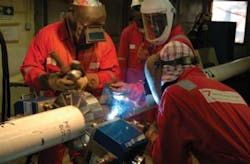Tombua-Landana: A monument to innovation off Angola
John Waggoner - Technology Editor, Drilling & Production
Located in approximately 1,200 ft (366 m) of water in block 14 offshore Angola, Chevron’s $3.8 billion Tombua-Landana development project is expected to achieve peak production of 100,000 b/d of crude oil in 2011.
Recoverable resources for the two fields are estimated at some 350 MMbbl. The 46-well project comprises a 1,554-ft (474-m) compliant piled tower (CPT), one of the world’s tallest manmade structures. The tower is the second one offshore Angola, and the fourth in the world.
The project is designed for zero discharge of produced water and zero routine gas flaring with associated gas to be commercialized at the Angola Liquefied Natural Gas project currently being constructed in Soyo, Angola.
Tombua-Landana, 50 mi (80 km) offshore, is seen as the next major step in Chevron’s development of block 14.
“Tombua-Landana is one of seven major projects coming online this year in which Chevron’s share of the investment is more than $200 million,” says George Kirkland, executive vice president of global upstream and gas.
The project incorporates the first use of a tender-assisted drilling rig for a fixed structure in deepwater and includes sulfate removal membranes for seawater treatment. The company plans to treat Tombua-Landana’s produced water and reinject it into the reservoirs. This is one of the first new-generation facilities offshore Angola to apply this technology to improve recovery and to reduce discharges to the ocean.
“Tombua-Landana highlights our strong commitment to Angola, where we are progressing more than a dozen large capital projects,” says Ali Moshiri, president of Chevron Africa and Latin America exploration and production. “Angolans comprise more than 80% of our in-country workforce, and the Tombua-Landana project, which is our third deepwater development in Angola, successfully engaged local suppliers to complete the manufacture of key multimillion-dollar project components.”
In addition to West Africa, the Tombua-Landana team involved many global work sites simultaneously, which required careful coordination and a dedication to safety. Work sites included engineering in Paris; Leiden, Netherlands; Oslo, Norway; Aberdeen, Scotland; and Houston. Fabrication and manufacturing included sites in Angola, Korea, the Netherlands, the United Kingdom, and the United States. These fabricated items had to be installed by seven different major construction vessels in Angola, all according to schedule.
Adding to the challenge was the fact that the construction was done during a peak in the industry when resources and materials were not only difficult to obtain but came at a cost premium due to demand.
“The team also responded well to changes when vessels did not arrive as expected,” says Jeff Brubaker, Tombua-Landana project manager. “We even met the challenges when fabrication was delayed by three major hurricanes. The team’s work has been superior, and they have every reason to be proud.”
Partners and project execution
The Tombua-Landana project is in approximately 1,200 ft (366 m) of water offshore Cabinda, Angola, West Africa, in block 14. Cabinda Gulf Oil Co. (a wholly owned subsidiary of Chevron Corp.) operates the project with a 31% interest.
Partners include:
- Sociedade Nacional de Combustiveis de Angola P&P (Sonangol) (20%)
- Eni – Angola Exploration B.V. (20%)
- Total E&P Angola (20%)
- GALP-Exploração e Produção (9%).
Tombua-Landana, Chevron’s third deepwater development in Angola, started with development and production from the Landana North reservoir in 2006 and continued in 2007 with pre-drilling of the Tombua and Landana central reservoirs.
The following companies were awarded project contracts:
- Daewoo Shipbuilding & Marine Engineering Co., Ltd. (DSME)
- Subsea 7 Installation Ltd.
- Acergy West Africa SASU
- Vetco Gray U.K.
Additional contracts included the Mobile Offshore Drilling Unit (MODU) to pre-drill platform wells and the Tombua South and Landana North subsea wells, the tender-assisted drilling rig (TAD) for drilling and completing all platform wells, the design and fabrication of the drilling template, and the provision of inspection services.
The EPCI contract for subsea installation was awarded to Subsea 7 in September 2006. The purchase order for flowline line pipe was placed in November 2006, with Subsea 7. The tieback facilities are comprised of production and water injection manifolds; production, test, water, and gas lift flowlines; flexible jumpers; and one control umbilical, including associated equipment and flying leads. Phase 1 of Subsea 7’s campaign, the flowline installation, was completed in July 2008, and Phase 2, the tie-in activities, was completed in February 2009.
The contract for the TAD was awarded to Seadrill in August 2006. The TAD arrived in August 2009, was moored adjacent to the DPP, and used for drilling operations. The derrick equipment set was placed on the DPP for well operations and removed when the drilling rig was demobilized.
The 35,300-ton (32,024-metric ton) operating weight Tombua-Landana platform is composed of a large integrated deck with production facilities and a 120-person accommodation building supported by a 56,400-ton (51,165-metric ton) compliant tower. The tower, a four-leg configuration, is secured to the seafloor by 12 foundation piles. The platform will provide a drill-deck for access to 38 well slots and be capable of simultaneous production and drilling operations with a TAD rig.
The EPCI contract for the drilling and production platform, including the supporting CPT, was awarded to DSME in July 2006. Kellogg Brown & Root, Houston, performed detailed engineering for the topsides while Mustang Engineering, also in Houston, provided detailed engineering for the CPT. Fabrication of the platform components for the pre-drilling template started in December 2006, at Sonamet’s facility in Lobito, Angola. Fabrication of the tower base template began in February 2007, at Heerema Vlissingen in the Netherlands.
Fabrication of the topsides modules started in August 2007, at Daewoo’s yard in Okpo, South Korea. Work on the two compliant tower sections began at Gulf Marine Fabricators in Ingleside, Texas, and Gulf Island Fabricators in Houma, Louisiana, in January 2007. Installation work was performed in Angola by Heerema Marine Contractors, with hookup and commissioning performed by DSME.
Operation of the new platform is handled by Cabinda Gulf Oil Co. personnel. The first installation phase of the CPT (the tower bottom template and the foundation piles) was completed in February 2008.
The EPCI contract for the export pipelines was awarded to Acergy West Africa SASU in September 2006. The purchase order for the oil and gas export line pipe was placed in February 2007. The gas export and the oil export pipelines were installed by Acergy in January and February 2008. The gas export pipeline, measuring 14-in. (36-cm) diameter and 19 mi (31 km) long, ties in to the Benguela Belize-Lobito Tomboco (BBLT) 16-in. (46-cm) gas export pipeline via a subsea piggable wye in 570 ft (174 m) of water.
The oil export pipeline (18-in. or 46-cm diameter and 16 mi or 26 km in length) ties in to the BBLT 20-in. (51-cm) oil export pipeline via a subsea piggable wye in 380 ft (116 m) of water. The DPP rigid export pipeline risers were preinstalled on the CPT and the export pipelines contractor installed a rigid tie-in jumper to these risers.
The EPC contract for subsea equipment was awarded to Vetco Gray, U.K., in September 2006. Fabrication of the manifolds at the Sonamet yard in Lobito started in August 2007. Vetco engineered, procured, fabricated, inspected, tested, and delivered the subsea equipment, including the tree system, manifolds and well jumpers, and production control systems.
An overview of development
The Tombua and Landana fields, discovered in 1997 and 2001 by the Tombua-1 and 14-6X/6XST1 wells, respectively, lie in the eastern part of block 14 and cover over 164 sq mi (425 sq km) in water depths of 900 ft to 1,700 ft (274 m to 518 m). Geographically, they are just south of the Lobito field and north of the Gabela oil discoveries.
The Tombua and Landana reservoirs are high-quality sands deposited in a deepwater slope valley environment on the northwestern flank of the Congo River fan. The identified resource base has oil in place of over 1 Bbbl held by a combination of structural and stratigraphic traps.
The development plan is designed to manage reservoir complexity, resource uncertainty, and technical challenges. There are 11 reservoirs to be developed by the initial project.
Many of the reservoirs are very near their bubblepoints, making pressure maintenance vital to maximum recovery. Therefore, there will be water injection at or near the start of production. The Tombua and Landana reservoirs contain high levels of barium in the produced water, requiring special seawater treating equipment to remove sulfates from before re-injection to prevent formation of barium sulfate scale in the wellbores and production equipment. Tombua-Landana also will use produced water reinjection for pressure support and to reduce the volume of seawater required to waterflood the reservoirs.
In late 2008, Chevron installed a compliant piled tower (CPT) to support a drilling and production platform (DPP) – the second such tower in Angola and one of the largest manmade structures on earth. Platform production was expected in 3Q 2009 and will reach a production rate of 100,000 b/d by 2011.
Two subsea manifolds – one a seafloor collection center for production and the other a water injection distribution point for injection wells – will tieback to the DPP to produce reservoirs and provide injection water for wells that cannot be reached from the platform.
Subsurface data – including 3D seismic, multiple reservoir penetrations, well tests, and wireline logs and cores – have been acquired. To predict the reservoirs’ performance, this data has been incorporated into 3D geologic and simulation models using state-of-the-art technology.


